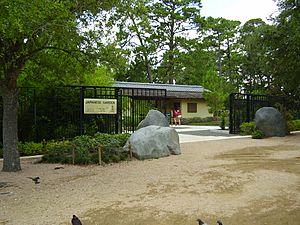Japanese Garden (Houston) facts for kids
Quick facts for kids Japanese Garden |
|
|---|---|

Entrance to the garden, 2009
|
|
| Location | Hermann Park, Houston, Texas, United States |
| Area | 5.5 acres (2.2 ha) |
| Designer | Ken Nakajima |
The Japanese Garden in Houston, Texas, is a beautiful Japanese garden. It covers about 5.5 acres (2.2 hectares) inside Hermann Park. A famous landscape designer from Tokyo, Ken Nakajima, created the garden. It first opened to visitors in 1992.
Contents
History of the Japanese Garden
How the Garden Began
In 1988, the top Japanese diplomat in Houston, called the Consul General, started talking with Houston's Mayor Kathy Whitmire. They wanted to create a Japanese garden in the city. A group called Japanese Garden Inc. was formed. Its goal was to raise money for the garden's design and building. Many Japanese business people living in Houston helped with this effort.
A Gift from Japan
In 1990, the Japanese Prime Minister Toshiki Kaifu visited Houston. As a special gift to the city, he arranged for a traditional Japanese teahouse to be donated. This teahouse was built in Japan using old methods. It was then taken apart and shipped to Houston. Japanese craftspeople put it back together without using any nails!
Before the teahouse arrived, Ken Nakajima was chosen to plan the garden. He believed in working with nature to create beauty. This idea is key to Japanese gardens.
Building and Opening the Garden
Work on the garden started on March 26, 1991. The main parts of the garden were finished before the teahouse arrived. A Houston landscape architect, Lauren Griffith, worked with Nakajima. They picked plants that would grow well in Houston but still look like a traditional Japanese garden.
After 14 months of building and planting, the Japanese Garden in Hermann Park was ready. It officially opened on May 4, 1992.
Restoring the Garden's Look
By 2006, the garden had changed a bit. Some people felt it looked more "American" than traditional Japanese. For example, flowers like petunias were planted, which weren't part of the original design.
So, Terunobu Nakai, who took over from Ken Nakajima, was hired to help. He visited Houston every year until he passed away in 2012. Nakai helped bring back the garden's original Japanese style. He taught local gardeners special pruning methods. He also explained that traditional Japanese gardens use fewer flowers. They focus on the shape of plants rather than big bursts of color.
Aya Hashimoto continued Nakai's work after 2012. She focused on improving the garden's edges and planning a new entrance.
In 2017, the garden celebrated its 25th anniversary. A special event raised over $600,000 to help with ongoing restoration work.
Design and Plants
Garden Style and Features
Houston's Japanese Garden is designed in the daimyo style. This means it looks like gardens built for powerful Japanese leaders long ago. The garden has winding paths that encourage you to walk slowly. You can enjoy different parts of the landscape and water features.
Traditional Japanese gardens use naturally weathered rocks. However, Houston doesn't have these. So, Nakajima chose large pink granite boulders from Marble Falls. He felt their size showed the strength of Texas.
Entering the Garden
Visitors enter through a traditional gateway. This gate has hidden rooms for things like a ticket booth and restrooms. A stone lantern at the entrance lights your way into the garden.
Stone lanterns are often the only sculptures in traditional Japanese gardens. There are three other stone lanterns in this garden. Two are yukumi-style, which are used for "snow viewing." One of these was a gift from Houston's sister city, Chiba, Japan. It sits across the pond from the teahouse. Another lantern is near a gazebo, a nice spot to rest by a stream.
Plants and Trees
The garden has many beautiful plants and trees. These include crepe myrtles, azaleas, Japanese Maples, redbuds, dogwoods, and cherry trees. There's also an old group of pine trees that were already there. In 1992, Nakajima listed 30 types of grasses and 121 types of shrubs he used.
The Japanese Garden is about 90 percent organic. This means they use natural methods for gardening. It also helps protect the Koi fish living in the pond.
Images for kids



